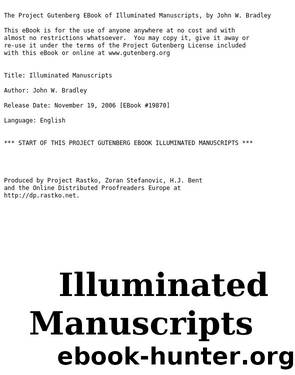Illuminated Manuscripts by John William Bradley

Author:John William Bradley [Bradley, John William]
Language: eng
Format: epub
Tags: Illumination of books and manuscripts
Published: 2006-11-18T16:00:00+00:00
* * *
CHAPTER IV
ENGLISH ILLUMINATION FROM THE TENTH TO THE FIFTEENTH CENTURY
Organisation of the Monastic scriptoriaâProfessional outsiders: lay artistsâThe whole sometimes the work of the same practitionerâThe Winchester Abbeys of St. Swithun's and HydeâTheir vicissitudesâSt. Alban'sâWestminsterâRoyal MS. 2 A. 22âDescription of styleâThe Tenison PsalterâFeatures of this periodâThe Arundel PsalterâHunting and shooting scenes, and gamesâCharacteristic pictures, grotesques, and caricaturesâQueen Mary's PsalterâRapid changes under Richard II.âRoyal MS. 1 E. 9âTheir cause.
In a former chapter we left our native schools of illumination at work on such MSS. as the Devonshire and Rouen Benedictionals, and with the reputation of being the best schools of the kind in Christendom. Mention also is made elsewhere in dealing with monastic art of the usages of the scriptoria. Such usages, of course, could only obtain in houses where scribes themselves were to be had. Hence we should discover, were it not otherwise known, that writing and illumination, even in the monastic age, were not confined absolutely to the cloister.
With respect to the secular scribes, who sometimes worked in the monastery, sometimes at their own homes, in those days when the monastic orders still did most of the book-production, there were three classes of specialists. These were the Librarii or ordinary copyists; the Notarii or law-scribes, whose business lay in copying deeds, charters, and such-like instruments, and taking notes in the courts; and Paginators or Illuminatores. It sometimes happened, as we have said, that in some monastery or other, no monastic was found qualified to undertake any of these duties. It then fell to the prior or abbat to seek the assistance of professional outsiders. The paging and rubrication, putting in initials in the spaces left by the common scribe, and, if needed, the addition of pictures or marginal drawings and ornaments, caricatures, heraldic illustrations, etc., were the proper work of the illuminator, but it often happened that the same man had to do the whole work from the commencement to the finish. The Chronicon Trudonense tells us: âGraduale unum propria manu formavit, purgavit, pinxit, sulcabit, scripsit, illuminavit, musiceque notavit syllabatim.â Several of our old English chronicles, of which the MSS. exist in the British Museum and elsewhere, seem to be of this description.
Reference has been made to the scriptoria at Winchester, i.e. at St. Swithun's and the New Minster. It is the latter foundation which is usually referred to in speaking of Winchester work. The Monastery of the Holy Trinity or the New Minster was founded in the first year of his reign by King Edward, son of Alfred, no doubt in obedience to his father's wish, if not absolutely in the terms of his will. Its first charter is dated 900 (for 901) and the second in 903. In the latter document the abbey is spoken of as dedicated to the Holy Trinity, the Blessed Virgin Mary, and to St. Peter, and is amply endowed under the Augustinian Rule. In 965, not without trouble and resistance, it was converted into a Benedictine abbey. In 968 Ethelgar, who
Download
This site does not store any files on its server. We only index and link to content provided by other sites. Please contact the content providers to delete copyright contents if any and email us, we'll remove relevant links or contents immediately.
Kathy Andrews Collection by Kathy Andrews(11731)
The remains of the day by Kazuo Ishiguro(8828)
Paper Towns by Green John(5092)
Spare by Prince Harry The Duke of Sussex(5074)
Industrial Automation from Scratch: A hands-on guide to using sensors, actuators, PLCs, HMIs, and SCADA to automate industrial processes by Olushola Akande(4986)
The Body: A Guide for Occupants by Bill Bryson(4975)
Machine Learning at Scale with H2O by Gregory Keys | David Whiting(4186)
Be in a Treehouse by Pete Nelson(3951)
Never by Ken Follett(3795)
Harry Potter and the Goblet Of Fire by J.K. Rowling(3775)
Goodbye Paradise(3728)
Into Thin Air by Jon Krakauer(3313)
The Remains of the Day by Kazuo Ishiguro(3295)
The Cellar by Natasha Preston(3262)
The Genius of Japanese Carpentry by Azby Brown(3226)
Fairy Tale by Stephen King(3220)
120 Days of Sodom by Marquis de Sade(3184)
The Man Who Died Twice by Richard Osman(2997)
Drawing Shortcuts: Developing Quick Drawing Skills Using Today's Technology by Leggitt Jim(2996)
